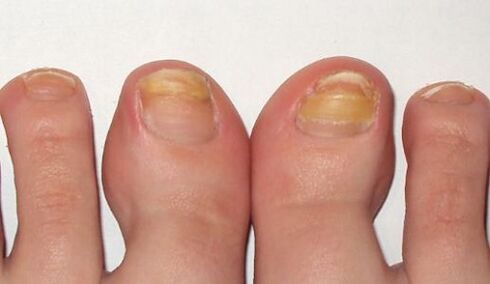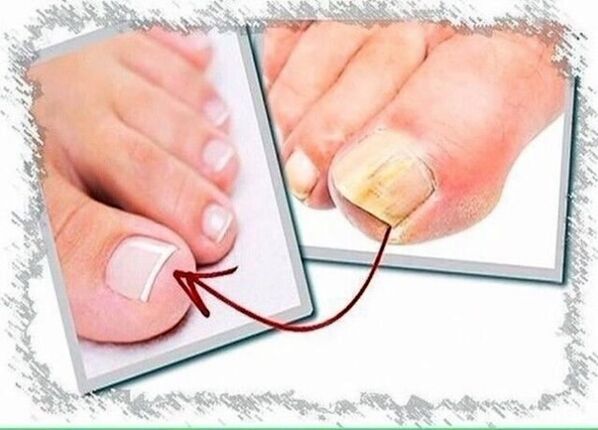Nail fungus (onychomycosis) is an infectious disease that affects every 5th adult on our planet. Infection occurs very quickly and is carried out by pathogenic fungi. You can "catch" the infection if you wear other people's shoes or neglect the rules of hygiene, as well as when visiting pools, saunas, etc. Diabetes, poor circulation in the feet, low immunity, damaged nails, being overweight and excessive sweating can all contribute to toenail fungus. How to determine nail fungus, what symptoms signal the manifestation of the disease? We will talk about it in this article.
Mycosis of the nails usually occurs on the feet, less often on the hands, but it can move from foot to hand and from one finger to another. This disease may seem mild, but it is very "survivable", causing physical and psychological discomfort. Treatment of the fungus is a very difficult and long process, if the disease is not detected in time or the symptoms are ignored, then serious disorders can occur: the fungus quickly grows on the nails and penetrates the internal organs, where it can cause severe damage. Therefore, in order to diagnose and recognize toenail fungus in time, it is necessary to know the first signs of toenail fungus. What are they?
Signs of foot fungus
As a rule, there are no significant changes in the initial stages, but if you miss the moment, diagnosis and treatment will become a problem. So how do you spot nail fungus? Signs or symptoms of nail fungus include the following:
- Changing the structure of the nail. The nail changes color (yellows), becomes brittle, rough and cloudy.
- Painful sensations in the lesion. The site of the appearance of the fungus hurts when in contact with shoes.
- Itching and burning on the skin. The skin near the infected nail becomes red and itchy.
- Falling out of the nail. In an advanced stage, nails infected with fungus can peel off.
There are 4 stages of nail fungus:
- The initial stage of nail fungus is almost never diagnosed (only medically). Barely noticeable white stripes appear on the nail plate, which indicates the presence of fungus.
- The second is characterized by a change in the appearance of the nail plate (you can recognize it yourself). The nail turns yellow, becomes cloudy and crumbles.
- The third manifests itself in noticeable deformation of the nail, and sometimes its partial separation. In addition, the skin around the fingers begins to itch, burn and peel off.
- The fourth is the busiest. The affected skin begins to crack, wet, and if left untreated, non-healing wounds appear.
Fungal agents

So why does fungus appear? Microorganisms called fungi (dermatophiles) are responsible for the damage to the body caused by fungi. And a certain environment allows them to multiply, so the causes of the appearance of the fungus include moisture and heat, which are formed as a result of wearing shoes that do not allow air or synthetic socks, and also if you do not wipe your feet dry after washing, damage to the nail - when the nail plate is cut under the root, wearing tight shoes, which only contributes to the weakening of the nail, such as acrylic or gel varnishes.
So what do nails affected by fungus look like? They are yellow, have lost their luster, crumble and partially exfoliate. If you have seen all these symptoms of nail fungus or some of them, you should immediately consult a specialist, because self-medication is just a waste of valuable time.
Nail fungus will not go away by itself, it will hit your body step by step, weakening it. That is why one of the main and most important symptoms of toenail fungus is its systemic nature.
Treatment of the causes of nail fungus
So, the first symptoms have been recognized and you have come to the doctor. A dermatologist or mycologist must first determine the type and extent of the disease (by taking a sample of the affected tissues) and make a diagnosis, then prescribe treatment. According to the degree of damage to the nail, normotrophic mycosis (when the color of the nail changes), hypertrophic mycosis (clouding of the nail and its thickening is added to the color change), atrophic mycosis (in addition to the change of the nail). in color and deformation, crumbling of the nail and its peeling appear).
Treatment begins with local preparations - these are ointments, patches and creams. Most often, they are used to restore the skin affected by the fungus. Antifungal varnishes are used to treat nails, the principle of their action is based on penetrating deep into the nail plate and eliminating fungal pathogens. On the surface of the nail, these drugs form a film that prevents the attack of a new infection.
In severe cases of the disease and the ineffectiveness of treatment with local drugs, the dermatologist prescribes antimycotic tablets. It is worth noting that in terms of their spectrum of action, they have a very serious effect on the body and have a number of side effects. When prescribing oral tablets and during their intake, it is necessary to take tests so that the doctor can monitor the course of treatment and their effect on the body.
There are also cases when specialists prescribe local drugs along with antifungal tablets. This happens in the most severe forms of the disease or in elderly patients, where the recovery process is slower. As a result of such therapy, the course of treatment is significantly reduced.
Folk remedies against fungi
Along with drug treatment, traditional medicine is also widely used in the fight against fungi.
Improper treatment is a step to worsening the disease! It should be remembered that folk remedies will not cure mycosis of the nails, but can only alleviate the condition and alleviate the symptoms. They can be used as an additional aid in treatment.
No treatment (medicinal or folk) will be effective if you do not follow certain rules of hygiene, this consists of tips to prevent fungus.
Prevention of mycosis of the nails

Preventing nail fungus is a fairly simple task, given some standard hygiene requirements that everyone can and should follow:
- Wear socks or tights made of natural fabrics and change them every day, and if your feet get wet during the day (several times a day), you should wash them, dry them and change the socks to dry ones.
- Change your shoes often. If you wear the same shoes day after day, always check (before going out) that they are dry from the previous walk. Remember that a moist environment encourages the formation of fungus.
- When visiting a manicurist and pedicurist, make sure the tools are in the right shape and condition. Feel free to ask a professional to disinfect all equipment.
- Low immunity is a prerequisite for the appearance of fungus. Enrich your diet with healthy foods: eat more fruits and vegetables - they are rich in vitamins, don't be lazy to eat garlic and nuts.
- Apply antiseptics. The most common among them is tea tree oil (a natural antiseptic), they can be used to treat the nails and the skin around them.
- Use only your own personal care products, as common items are a safe route for fungus. You must have your own toiletries (towel, brush, comb, scissors); also, when visiting public places (bathroom, pool, sauna, gym) you should only wear your own shoes (even in the shower).
Prevention is the easiest way to avoid fungus! By regularly following the simple (above) rules, you will not have to get rid of the "stubborn" mycosis of the nails for a long and painful time. Personal hygiene: the key to health.
Generalization
So how do you identify nail fungus? You should examine the appearance of the nail, as well as pay attention to the symptoms and signs of the fungus. If there is still mycosis of the nails, you should urgently contact a dermatologist or mycologist, but do not self-medicate so as not to miss valuable time. To treat the fungus only with drugs (under the supervision of a doctor), folk remedies can be used as auxiliary therapy. And the most important thing: you need to follow the rules of personal hygiene (no matter how much you think that these are trifles and some of them can be neglected) in order to avoid such an unpleasant disease as nail fungus and not to encounter it.















